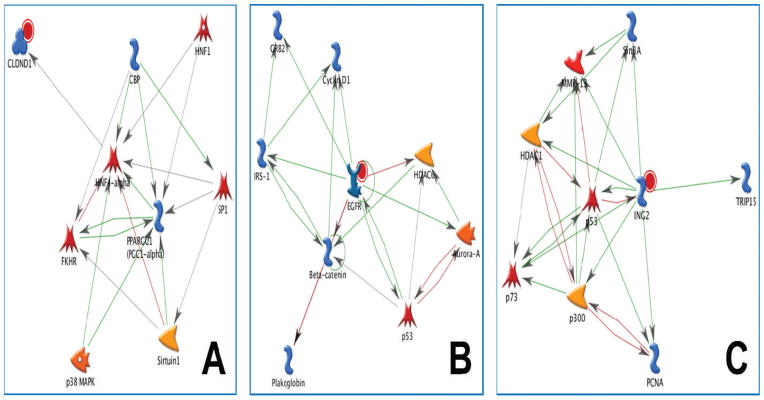FIG. 3.

Networks of low-dose radiation responsive genes linked to carcinogenesis. Gene networks built in MetaCore (version 6.2) are shown. Panel A: CLDN1 network. Transcription of CLDN1 is regulated by HNF4α (hepatocyte nuclear factor α); SP1 (transcription factor) and HFN1 (hepatocyte nuclear factor 1) regulate the transcription of HFN4α; FKHR (Fork Head Box O1) physically interacts with HNF4α and decreases its activity; HNF4α is activated through association with CBP (CREB binding protein); FKHR is acetylated by CBP and deacetylated by Sirtuin 1 (NAD dependent deacetylase); CBP regulates the transcription of PPARGC1 (peroxisome proliferator-associated receptor γ coactivator 1α) and activates SP1 via acetylation; SP1 regulates the transcription of Sirtuin 1 and PPARGC1; PPARGC1 is activated through p38MAPK (p38 mitogen-activated protein kinase) phosphorylation and Sirtuin 1 deacetylation; binding of PPARGC1 activates HNF4α. Panel B: EGFR network. EGFR is activated by autophosphorylation upon ligand binding. Interactions of activated EGFR with cellular components lead to cell proliferation. EGFR recruits the GRB2 (growth factor receptor bound protein 2)/Sos (son of sevenless) complex, leading to activation of the Ras pathway; EGFR phosphorylates IRS-1 (insulin receptor substrate 1) and binding of activated IRS-1 activates GRB2; EGFR inhibits β catenin through phosphorylation; β catenin activates the transcription of IRS-1 and cyclin D1 and inhibits plakoglobin by direct binding to it; IRS 1 activates the transcription of cyclin D1; EGFR phosphorylates HDAC6 (histone deacetylase 6) and reduces its activity; HDAC6 activity is increased by Aurora A (serine/threonine protein kinase 6) phosphorylation, and HDAC6 is regulated at the transcriptional level by p53 (cellular tumor antigen p53); nuclear EGFR/STAT5 (signal transducer and activator of transcription 5) regulates the transcription of Aurora A, whose expression is inhibited by p53; phosphorylation of p53 by Aurora A abrogates p53 DNA binding and transactivation activity. Panel C: ING2 network. ING2 activates TRIP15 (COP9 signalosome complex subunit 2), PCNA (proliferating cell tumor antigen), Sin3A (paired amphipathic helix protein A), p73 (tumor protein) HDAC1 (histone deacetylase 1), and p300 (histone acetyltransferase) through direct binding; ING2 and Sin3A activate MMP13 at the transcriptional level; ING2 activates p53, while p53 inhibits ING2 at the transcriptional level; binding of Sin3A activates MMP13, which in turn regulates the transcription of p73 and MMP13; HDAC1 and p300 inhibit each other; HDAC1 activates MMP13; p300 and PCNA inhibit each other; p300 is a coactivator of p53; p53 inhibits MMP13 at the transcriptional level; p53 and p73 activate each other at the transcriptional level.
